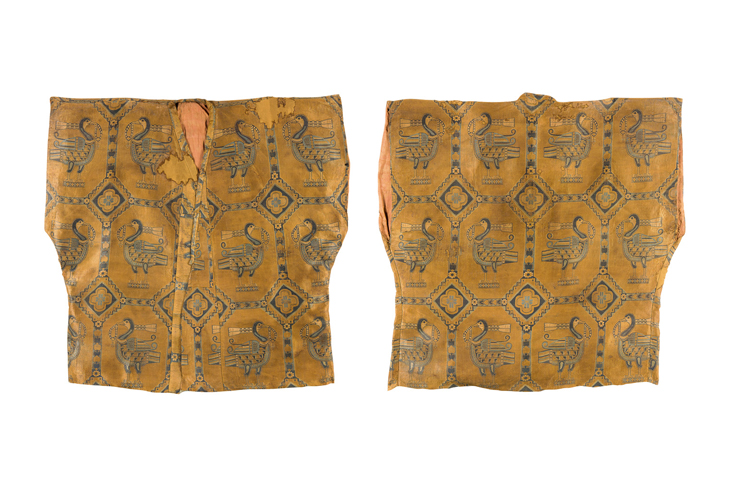Silk shirts are not particularly exceptional – unless, of course, they happen to be a thousand years old. The example illustrated here is even older, perhaps dating to the seventh century but probably no later than the ninth. Luscious and still shimmering, the honey gold ground is decorated with blue ducks draped in billowing scarves and carrying pearl necklaces in their beaks. The shirt’s survival in remarkable condition is all but miraculous, vivid testimony to the multicultural milieu in which it was produced.
This textile is most likely from Sogdiana, not so much a nation state as a constellation of principalities united by economic interests located in what is now Uzbekistan and Tajikistan. The Sogdians were acknowledged as the great merchants and suppliers of the Silk Road. Theirs was the lingua franca of this trading network, which linked China, Central Asia and Persia with Rome and the Byzantine Empire, and which derived its name from the extensive trade in silk carried out across the network. Expensive and easily portable, silk came to be used as an international currency as well as a symbol of power and prestige.
Initially intermediaries in the silk trade, the Sogdians began to weave their own magnificent textiles in the fifth century, melding motifs from a range of religious sources to create a widely appealing and essentially secular imagery. The imagery here mostly derives from Sasanian Persia, as does the technique for producing the cloth itself. The Sasanians had produced the first known examples of pictorial loom-woven bolts of cloth, created by coloured wefts that almost entirely cover the warp in a compound twill structure known as samite. Characteristic of their silks were symmetrical patterns of pairs of usually winged animals or birds, standing face to face and set in roundels surrounded by pearls. Unlike these prototypes, the birds and beasts of the Sogdian silks are stiffer and more abstracted, and motifs of hearts and rosettes abound.
Similar pairs of embroidered ducks confront one another on a seventh- or eighth-century damask at the Abegg-Stiftung in Switzerland, but the pattern of this shirt most closely resembles that of an eighth-century jacket made for a child, presumably a prince, now in the Cleveland Museum of Art along with matching boots and trousers of Chinese silk – another extraordinary survival. (The suit is said to have come from Tibet, the climate of which allowed for its astonishing state of preservation.) This shirt is thought to have been acquired by its French owner in Hong Kong. Now it comes to auction at Sotheby’s in London, on 25 April.
Given its extraordinary rarity as a near-pristine and apparently complete garment, the shirt’s estimate of £300,000–£500,000 seems modest. The reason, according to the auction house’s specialist Alexandra Roy, is that such textiles tend to fall between collecting categories. Although the shirt is offered in a sale of Islamic art, it is thought to have been made by Sogdian weavers who migrated to Tang China in the period around the conquest of their territories by the Abbasids in the eighth century – making it in fact a pre-Islamic artefact. Moreover, the storage conditions required for such fragile textiles are not for the faint of heart. As for their permanent display, that is an impossibility – all the more reason to rush over to Sotheby’s where the shirt will be on view for four days before the sale (20–24 April).
The Arts of the Islamic World sale tales place at Sotheby’s London on 25 April.
